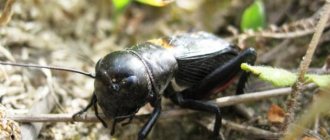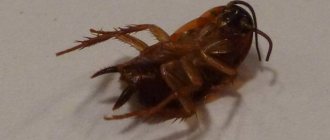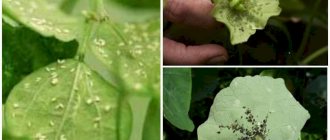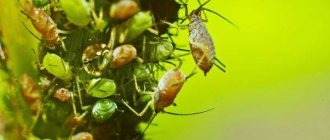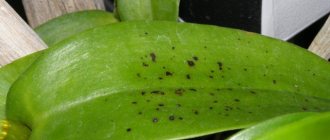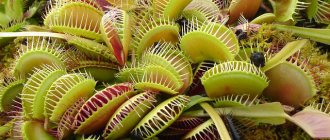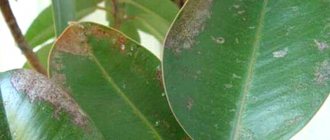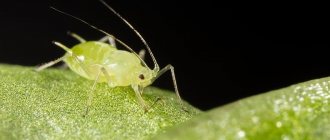Whitefly is a sucking pest of cultivated plants. The insect is small in size and resembles aphids, with the only difference being the white color of the body. It prefers to settle in large groups on young shoots and leaf blades, where it can easily feed on plant sap. The inside of the leaves provides an excellent place for laying eggs. Subsequently, larvae emerge from them, capable of moving independently in search of tender areas of the plant necessary for feeding.
At this stage, whitefly poses the greatest danger to greenhouse crops. After some time, the larvae stop feeding and become inaccessible to all types of insecticides. Their body is covered with a waxy coating. During this period, under reliable protection, the formation of an adult insect occurs. After emerging from a kind of cocoon, the pest firmly attaches itself to the plants and begins to actively drink the juice. At the same time, his body is still reliable, protected by a waxy coating.
Subsequently, the older generation of whiteflies migrates to neighboring plants and the life cycle of the pest repeats again. It is worth noting that insects consume more juice than they need. All excess nutritional fluid is excreted from the body by “honeydew,” which is a fertile environment for the development of many fungal diseases.
Whitefly: what kind of insect is it?
The whitefly, or aleurodidae, is an almost invisible parasite that destroys garden plants. The insect loves indoor flowers, tomato seedlings, peppers, cucumbers, and eggplants. The parasite is especially common in greenhouse conditions. Succulent foliage is eaten by individuals at all stages of life development. To get rid of a butterfly, you need to apply a whole range of preventive measures and use special means for treating summer cottages.
Types and classification of pests
There are about 1,500 species of whiteflies in the world, which differ in habitat and food preferences. In greenhouse conditions, the parasite can constantly multiply, move, and transmit viral and fungal diseases. Eating the lower part of the stems and foliage leads to wilting of plants. Gradual damage to vegetable beds can significantly reduce yields.
Description of the main varieties of whiteflies found in temperate climates:
- Tobacco and cotton. The insect settles on various crops: turnips, beets, cabbage, indoor flowers, outdoor plants, tomatoes, potatoes.
- Greenhouse. It lives in the soil of greenhouses and greenhouses, where the climate is always temperate. Found on indoor plants in warm apartments. This whitefly feeds on vegetable or ornamental crops.
- Citrus. It feeds on tangerine, lemon, orange or lime leaves. In Russia it is found in greenhouses or in the south of Crimea and the Caucasus.
- Cabbage. It settles on cabbage, namely, eats the leaves of the crop at the end of August.
- Strawberry. The whitefly eats strawberry foliage, reduces yield, and harms the fruits of the plant.
Cabbage and strawberry whiteflies are not particularly dangerous for the garden. The insect produces only one offspring during the entire season, and you can get rid of the butterfly invasion by simply washing off the parasite with water. In apartments, aleurodids feed on fuchsia, begonia, orchid, geranium, balsam, passionflower or lantana. They can migrate to neighboring plants.
Habitat and suitable conditions for existence
Whiteflies love warmth and high humidity. Therefore, the parasite can develop year-round in greenhouses, with 3-4 generations present in one area at once. In a garden or greenhouse, the parasite begins to appear en masse in July, when there is intense heat (over 30°C). When the temperature drops below 10°C, adults and larvae die, but eggs laid in the soil are able to overwinter.
This is interesting! You can meet whiteflies in home mini-greenhouses, which are organized on window sills. The insect infects seedlings and then moves to indoor flowers.
Appearance
The whitefly looks like a small moth or white butterfly. The length of the body reaches 2-3 mm. The wings of the pest are covered with a waxy coating, which protects it from the action of chemicals. The parasite larvae are located on the inside of the leaf, on the lower stems of the crop. First instar worms have an oval shape, antennae, and 6 legs. A couple of days after birth, the parasite settles in one place and looks like a microscopic whitish scale. When you shake the affected plant, you may notice a small cloud of small adults.
Life cycle of a whitefly
A female can mate up to 10 times in a month of life. The life cycle of a parasitic butterfly includes many stages, which complicates the fight against insects. The easiest time to get rid of the pest is when the “vagrant” larvae just appear and become vulnerable in search of juicy leaves.
Stages of whitefly maturation:
- the adult female lays eggs;
- after 14 days, first-instar whitefly larvae emerge from the clutch and can search for a suitable habitat for a long time;
- second instar larvae stop at the most succulent areas and become covered with a waxy coating;
- larvae of 3-4 instars, or nymphs, fully feed, but do not yet have the ability to move.
The cycle ends after the adult (imago) begins to move to neighboring plants and beds. Mating of a female with a male occurs 12-20 hours after departure. It is best to kill the insect at this stage, before it has time to lay eggs. The second instar larvae cannot be processed mechanically and are resistant to chemical sprays.
Reproduction and distribution
One individual in just a month of life is capable of laying up to 250 eggs, or 15-20 at a time. After 40 days, adult butterflies develop from the hatched whitefly larvae, which can migrate to other crops and move throughout the greenhouse or garden plot with the help of the wind. The maximum abundance of the pest occurs in July-August, when hot and rainy weather prevails. With the onset of cold weather, the insect dies, but the eggs remain overwintering in the soil to begin their life cycle again in June.
Signs of insects
You can notice the infection of plants at the initial stage by carefully examining the lower leaves and stems. If small white butterflies appear when shaking the bushes, the whitefly larvae have already caused serious damage to the plant. It is urgent to begin fighting the insect using chemicals, remove infected leaves and bushes from the garden bed, and poison the soil.
The main symptoms that indicate plant damage by the whitefly butterfly:
- the appearance of translucent scales on the reverse side of the leaf;
- whitish sticky coating (honeydew) on the leaves;
- slower plant growth, lack of fertility;
- the appearance of dark spots.
Whitefly traces, or honeydew, are produced by larvae. These secretions can tighten the leaves of the plant, not giving it enough light and moisture. As a result, flower and vegetable crops begin to wither, the leaves curl, turn yellow, dry out, and fall off. The sweetish coating also attracts ants, which can settle in the greenhouse and bring aphids to the plant.
Preventive actions
Ageratum, a low flowering plant that is toxic to whiteflies, has a good effect for controlling flying insects in greenhouses. Fumigating greenhouses with a sulfur bomb in early spring helps get rid of all pests and fungi. Butterflies also cannot withstand cold weather; as soon as the air temperature drops below 10-12o C they die.
Main causes of pest infestation
To prevent crop diseases, you should know where whiteflies come from in greenhouses and on indoor plants. There may be parasite eggs in the soil. Therefore, when planting plants, it is necessary to carefully treat the soil, even if it is purchased. The following conditions also provoke the appearance of butterflies:
- frequent watering of the plant;
- high humidity and temperature more than 30°C in the greenhouse, rainy hot summer;
- close planting of crops to each other;
- lack of ventilation in greenhouses, greenhouses, apartments.
A pest can enter an apartment through open windows and doors. Therefore, it is recommended to regularly inspect the leaves of indoor plants and wipe them with disinfectants. Also, do not place flowers too close to each other.
☝️ Features of application
Among the application features, the following important points are highlighted:
- The use of Yellow Dodger can be combined with insecticide treatments.
- In order not to harm the bees, you should not hang traps during the period of active flowering of garden shrubs and trees. The rest of the time they are hung at a distance of at least 1 m from the main flight path of the bees.
- A visual inspection will help determine the suitability of a biotrap over time. If there is enough free space to catch new insects, the trap is operational.
If you find an error, please select a piece of text and press Ctrl+Enter.
What harm is caused?
Honeydew, which the whitefly leaves on the leaves, provokes the appearance of sooty fungus. It clogs the pores of the plant, which is why the crop gradually dies from lack of oxygen and sun. The spores spread in the wind and remain in the soil. Therefore, a small butterfly can cause crop destruction in the entire greenhouse. Infected plants are removed from the site and burned.
Whitefly is a carrier of the following diseases: leaf curl virus, golden mosaic, infectious yellowing of fruits and crop stems. When the first symptoms appear, treatment is useless; it is necessary to urgently get rid of the affected plants.
Read more about how to effectively get rid of butterfly pests in your garden and vegetable garden in the article here.
Damage to berry crops
Under favorable conditions, the whitefly feels great in open ground. Its widespread distribution is especially observed in the humid and hot climate in the south of the Russian Federation. The whitefly reproduces well on strawberries and raspberries, and does not disdain currant bushes and apple trees.
It is easy to detect the presence of a pest - just touch a strawberry bush, a branch of a tree or bush, and myriads of midges rise up. They densely adhere to the outer and inner parts of the leaf, leaving traces of vital activity in the form of whitish spots on the surface. Strawberry and raspberry leaves look as if they are dirty.
It is important to know! The strawberry whitefly is a separate type of parasite; its appearance and life cycle are very similar to the greenhouse whitefly. It affects plant tissue, reducing productivity, causing leaf curling or the death of an entire bush.
Means to combat butterflies and their larvae
It is not easy to eliminate the pest from the beds, but if you use an integrated approach, it will be possible to defeat several generations of whiteflies at once. Chemical treatment of soil and plants against parasites should take place before planting seedlings and before the start of the vegetative stage. Folk recipes, mechanical methods and biological products are allowed to be used throughout the spring-summer season. In enclosed spaces, special fumigators deal with the butterfly.
10 ways to get rid of whitefly butterflies forever
Glue traps
To combat adult individuals, sticky traps are used. When flying from plants or beds, most whiteflies fall into placed traps. You can buy them in gardening stores, use regular sticky fly strips. You can make a trap yourself from cardboard or plastic, smeared with rosin, honey, Vaseline, or entomological glue. The parasite is also attracted to light from a light bulb, which burns their thin wings.
This is interesting! Homemade traps should be made on sheets, plywood, yellow or blue plastic. It is these shades that are attractive to insects.
Chemicals
Chemicals help get rid of whiteflies quickly and protect plants for another 4-8 weeks. Insecticides enter the insect's body and intestines (intestinal-contact effects), causing complete paralysis and death from exhaustion within 2-3 days. It is not recommended to treat vegetable crops with toxins after flowering and the appearance of ovaries. Chemicals can also poison the population of beneficial insects: ladybugs, bees, wasps, lacewings.
“Fitoverm”
The safest insecticide that will remove whiteflies will not harm the health of humans, animals, or other beneficial insects. It is recommended to spray the soil, foliage, and inflorescences of plants. To exterminate all pests, 2 treatments with a break of 7 days are enough. The composition is effective for 3 weeks, becoming less effective after rains. An analogue of the product is “Match”, “Aplaud”.
“Aktara”
A universal chemical preparation allows you to immediately poison whiteflies, aphids, midges, and leaf beetles. The toxin from the soil is absorbed into the foliage and stems of plants and remains active for about 5 weeks. If you need to kill large concentrations of pests, you can make a concentrated solution. To do this, a bag of Aktara is diluted in 3 liters of water, instead of 10 liters. This dose will kill all butterflies and larvae, but the seedlings will not be harmed.
"Spark"
“Golden Spark”, “Iskra – double effect”, “Bio-Iskra” are sold in the form of sticks, tablets, ampoules, which are used according to the instructions. The chemical preparation will save the crop from whiteflies and aphids after just one spraying. An irrigated bush contains toxins for up to 30 days, during which time the entire pest population dies.
You should not re-treat plants with the same preparation. The insect will be able to adapt to the toxic composition.
Folk recipes
The fight against whiteflies at home begins with the use of folk methods. Recipes based on herbal decoctions, infusions, household chemicals, and improvised means allow you to get rid of many pests. The natural composition of solutions for spraying beds does not accumulate in the soil, promotes better productivity, does not harm beneficial insects, and does not burn seedlings.
Soapy water
The soap solution washes off the protective wax film from the insect, paralyzes it, and causes death within 2-3 days. To prepare the product, you need to take a bar of laundry or tar soap, grate it and dilute it in 6-7 liters of water. You can spray the bushes with a spray bottle or manually wash each leaf with a foam sponge.
Garlic infusion
The tincture is used to treat indoor plants. To prepare it, just pour 2 chopped cloves of garlic with boiling water and place in a dark and cool place for a day. After infusion, the product is filtered and poured into a spray bottle. To kill the entire whitefly population, treatment is carried out every week for a month.
Infusion of yarrow herb
You can get rid of whiteflies using yarrow juice. To prepare the infusion, take several bushes, chop it finely, knead it with your hands, and pour 4 liters of boiling water. The product is infused for 2 days, then filtered and diluted with another 4 liters of water. For better adhesion of the composition, it is recommended to add about 30-40 ml of liquid soap or shampoo before processing the beds. The medicinal plant can be replaced with celandine.
Tobacco infusion
Tobacco can be used to control small infestations of whiteflies. You need to buy 1 pack of cheap cigarettes, take out the contents, pour 1 liter of boiling water. To infuse, the mixture is sent to a dark and cool place for 5 days. After the strained product, spray the affected plants every 3 days.
Dandelion decoction
To prepare the product, take juicy dandelion bushes (along with roots), chop them finely, pour in 1 liter of boiling water, and then leave the mixture on low heat for 15 minutes. To make the tincture, the herbal decoction is sent to a dark place for 4 days. If it is necessary to treat greenhouses, greenhouses or garden beds, the serving volumes increase 10 times.
Ammonia
The pungent smell of ammonia repels small pests, fertilizes the soil, and helps enhance the growth and flowering of indoor plants. 2 tbsp is enough for a bucket of water. l. ammonia, 30 ml of liquid soap. Treatment is carried out after 18.00 or in cloudy weather, so as not to burn the tender leaves of the seedlings under the scorching sun.
On a note! You can replace ammonia with vinegar. Its smell is also harmful to insects.
Ash
Wood ash helps save beds from whiteflies, fleas, and aphids. It is sprinkled on the soil under the plants, treated between rows or irrigated with a solution on the foliage. You need 1 tbsp. ash, pour 5 liters of water, boil over low heat for about 15 minutes. Afterwards, the broth is cooled and the beds are irrigated with a broom.
Sugar tincture
Sugar infusion is suitable for preventing the appearance of whiteflies on plants. Plants that were in the same greenhouse or nearby with affected crops are treated with a safe product. To prepare the solution, take 200 g of sugar, 1 liter of warm water, mix the ingredients and spray the leaves.
In order for the plant to receive sufficient oxygen and light, 5-6 days after treatment, the sugar solution must be washed off from the leaves.
Mechanical methods
Control whiteflies in small areas manually. It is enough to inspect each leaf of the plant from the inside several times a week. If larvae and butterflies are found, they are shaken off, killed, and washed off with soapy water. Regular watering with a hose is also recommended to force pests down to the ground.
Biological measures
Biological insecticides act in the same way as chemicals, but have a more natural, safe composition. The treatment can be carried out after the formation of the ovaries, does not make the fruits toxic, and the fumes do not harm humans and animals. The most effective product, Verticillin G, contains spores of a fungus that is dangerous to insects. After poisons enter the intestines, the whitefly begins to get sick, infects other individuals and dies after 8-10 days.
Biological measures also include introducing beneficial insects into the beds that feed on whiteflies. Encrasia is a parasitic parasite that lays its eggs in butterflies. It can also suck juice from immobile larvae. Ladybugs and macrolophus bugs love to eat the parasite. To attract predators, dill, marigolds, and daisies are planted around the perimeter of the site.
Fumigators
In greenhouses, conservatories and apartments, you can use a fumigator against mosquitoes and flies. They are placed around the perimeter at an equal distance from each other, windows and doors are closed. While the device is active, you must leave the premises and take your pets. Toxic fumes are effective on butterflies and larvae, but are not harmful to eggs. Therefore, after a few weeks the procedure is repeated.
How to do it yourself
You can easily make your own yellow glue traps by following the instructions below.
✂️ What you will need
To make traps you will need:
- 25 sheets of polished paper;
- 70 g of “Yellow Dodger” glue;
- Spatula for applying glue.
